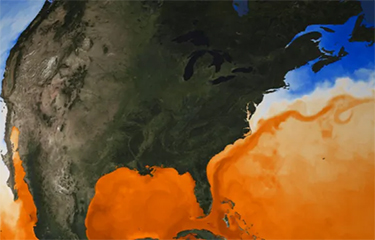Researchers from the Woods Hole Oceanographic Institution confirmed with 99 percent certainty that the Gulf Stream is weakening, and with it the future of seafood species like lobster off the U.S. East Coast is uncertain.
The Gulf Stream transports warm water north from Florida along the East Coast of the U.S., influencing everything from water temperature to weather in Europe. According to a recent study, the Gulf Stream has slowed by 4 percent over the past four decades, and there is 99 percent certainty that the weakening is from more than just random chance.
“This significant trend has emerged from the dataset only over the past ten years, the first unequivocal evidence for a recent multidecadal decline in this climate-relevant component of ocean circulation,” the Woods Hole study said.
The shifting Gulf Stream is occurring at the same time as the lobster population in the Gulf of Maine has experienced a sharp decline, with recent assessments showing that the population of young lobsters dropped by nearly 40 percent over three years. The decline in lobsters is occurring at the same time as a population increase of blue crabs – which favor warmer water – in the Gulf of Maine. While the exact reason for the decline is still unclear, scientists have speculated warmer waters will mean fewer lobsters.
Scientists have been sounding alarms regarding the lobster population since 2016, when they noticed an intermediary stage of lobster growth was missing for unknown reasons. At the time, scientists said there were abundant egg-laying females, and plenty of baby lobsters, but fewer intermediary lobsters. Surveys in 2022 also showed that there was a decline of baby lobsters on the bottom of the ocean in the Gulf of Maine, while the Gulf of Saint Lawrence to the north saw an uptick.
A potential drop in younger lobsters was expected and accounted for by the Atlantic States Marine Fisheries Commission (ASMFC), but not so soon. The ASFMC instituted new rules in 2017 that would trigger an increase in the gauge size of lobster in Maine’s fishery, which would effectively increase the size of lobster fishermen would need to catch. The rules would go into effect if juvenile lobster were found to have declined by 35 percent in trawl and ventless trap surveys.
Then, on 16 October 2023, the Lobster Board of the ASMFC was told that the combined results of the latest trawl and trap surveys showed a decline of 39 percent – 4 percent more than the addendum. The fact that the change came so quickly, Maine Department of Marine Resource Commissioner Patrick Keliher said in an email, came as a “significant surprise.”
The ASFMC has since delayed the implementation of the gauge size changes, but the survey results aren’t new. While the exact cause of the decline in lobster populations is unclear, scientists have speculated that a decline in certain copepods, ocean acidification, or warming waters from the shifting Gulf Stream could all be to blame.
Photo courtesy of NOAA







